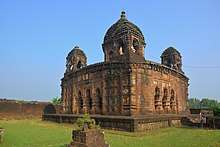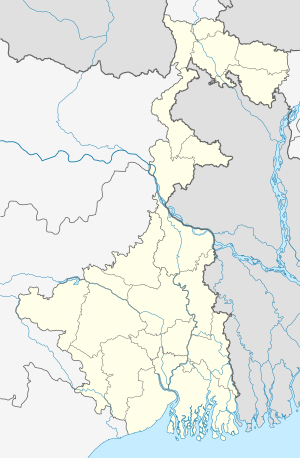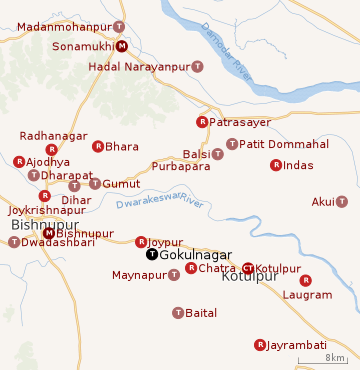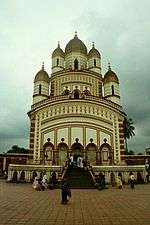Gokulchand Temple
Gokulchand Temple is a 17th-century stone built pancharatna temple in Gokulnagar village in the Joypur CD block in the Bishnupur subdivision of the Bankura district in the state of West Bengal, India.
| Gokulchand Temple | |
|---|---|
 Gokulchand Temple | |
| Religion | |
| Affiliation | Hinduism |
| Location | |
| Location | Gokulnagar Bankura district |
| State | West Bengal |
| Country | India |
 Shown within West Bengal  Gokulchand Temple (India) | |
| Geographic coordinates | 23.0412°N 87.4617°E |
| Architecture | |
| Type | Pancharatna |
| Completed | 17th century |
Geography
 |
| Places in Bishnupur subdivision in Bankura district M: Municipal town, CT: census town, R: rural/ urban centre, T: ancient/ temple centre Owing to space constraints in the small map, the actual locations in a larger map may vary slightly |
Location
Gokulnagar is located at 23.0412°N 87.4617°E.
Gokulnagar is off the State Highway 2 at Salda.[1]
Note: The map alongside presents some of the notable locations in the subdivision. All places marked in the map are linked in the larger full screen map.
The temple
David J. McCutchion mentions the Gokulchand temple at Gokulnagar as one of the earliest pancharatna temples of the Malla kings. It has turrets on four columns, a kind of chhatri, instead of the corner wall sections. Along with the at-chala, the pancharatna is the most popular type of temple in Bengal. With a 45 feet square base, it is built of laterite with stucco figures. According to the badly damaged temple plate it was built in 1639 (and that obviously goes with a question mark).[2]
This pancharatna (five pinaccled) temple at Gokulnagar is the largest stone temple in Bankura district. It is 64 ft. in height and the area of temple complex is 23,500 sq. ft. According to the ASI information board at the temple, it was built in 1643, during the rein of the Malla king, Raghunath Simha. The style of construction of the temple is similar to that of the Shaymaraya temple at Bishnupur. The wall decorations depict various avtars of Vishnu and raslila motifs and other mythological incidents.[3][4]
The temple was in a bad shape and plundered till it was taken over by the Archaeological Survey of India in 1996. The idol of Lord Krishna has long been removed to Bishnupur. The complex is abuzz with activity when the idol is brought back for 5 days during Holi and worshipped here.[1]
Gokulchand Temple is included in the List of Monuments of National Importance in West Bengal by the Archaeological Survey of India (serial no. N-WB-31).[5]
Gokulchand Temple picture gallery
.jpg) Gokulchand temple
Gokulchand temple.jpg) The central top strcture
The central top strcture.jpg) A corner structure
A corner structure.jpg) The central top structure doorway
The central top structure doorway.jpg) Roof support
Roof support.jpg) Natmandir
Natmandir.jpg) Stone relief
Stone relief.jpg) Stone relief
Stone relief.jpg) Stone relief
Stone relief.jpg) Stone relief
Stone relief.jpg) Stone relief
Stone relief.jpg) Stone relief
Stone relief
The pictures are a part of Wiki Explores Bankura programme, an initiative by West Bengal Wikimedians User Group
References
- Sengupta, Somen. "Next week end you can be at Gokulnagar". The Telegraph, 16 January 2011. Retrieved 17 April 2020.
- McCutchion, David J., Late Mediaeval Temples of Bengal, first published 1972, reprinted 2017, pages 10, 11, 44, 45. The Asiatic Society, Kolkata, ISBN 978-93-81574-65-2
- Ghose, Indrani. "Laterite temple of Gokulnagar, West Bengal". I share. Retrieved 1 April 2020.
- "Gokulnagar, a small village in Bankura district of Bengal". Trips Around. Retrieved 17 April 2020.
- "List of Ancient Monuments and Archaeological Sites and Remains of National Importance". West Bengal. Archaeological Survey of India. Archived from the original on 27 June 2014. Retrieved 17 April 2020.
External links
| Wikimedia Commons has media related to Gokulchand temple, Gokulnagar. |
